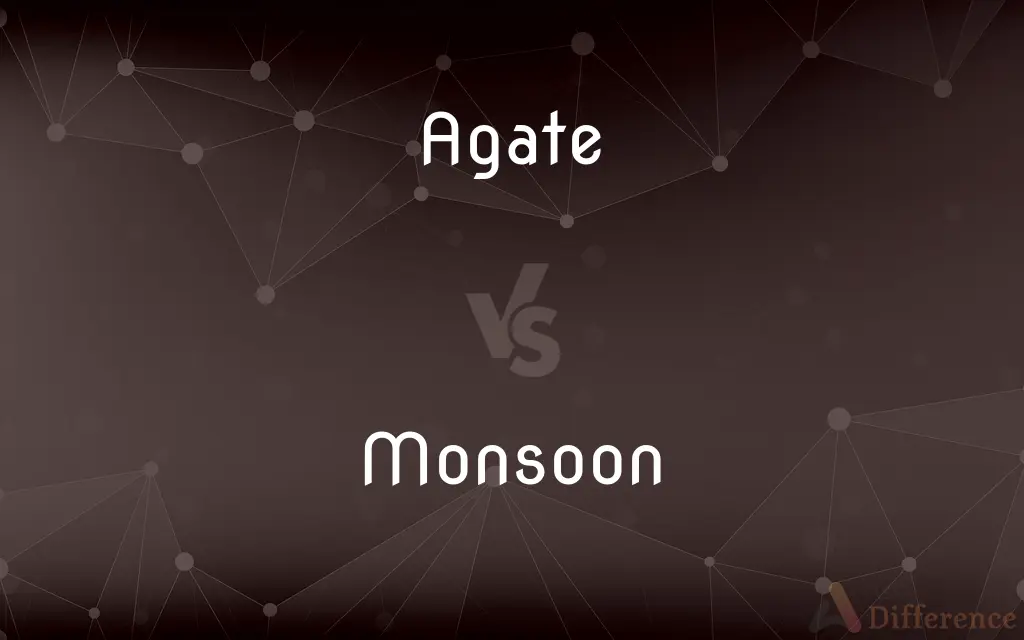Agate vs. Monsoon — What's the Difference?
By Tayyaba Rehman & Urooj Arif — Updated on April 16, 2024
Agate, a variety of quartz known for its fine grains and colorful bands, is primarily a geological entity; monsoon refers to a seasonal reversing wind system accompanied by changes in precipitation.

Difference Between Agate and Monsoon
Table of Contents
ADVERTISEMENT
Key Differences
Agate is a naturally occurring mineral, specifically a variety of chalcedony that exhibits a wide range of colors and intricate patterns. This mineral is predominantly used in jewelry and decorative items due to its aesthetic appeal and hardness. Whereas, monsoon is a climatic phenomenon characterized by a seasonal reversal in wind direction, which significantly impacts weather patterns and precipitation in large regions, particularly in South Asia and Africa.
Agate formations occur in volcanic and metamorphic rocks as secondary deposits in cavities called vesicles. These stones are prized for their concentric bands of color, which are the result of periodic crystallization. On the other hand, monsoons are driven by temperature disparities between land and sea, causing large-scale shifts in wind patterns. These winds are responsible for bringing significant rainfall during the wet season, crucial for agriculture in monsoon-dependent regions.
The value of agate is primarily determined by its unique banded patterns and colors, which can range from transparent to opaque. Collectors and artisans often seek out rare patterns and colors for high-value pieces. Whereas, the value of a monsoon is ecological and agricultural, as these rains are vital for the crops and water supply of the regions they affect, although they can also cause severe flooding and disruption.
While agate can be found in various parts of the world, including Brazil, India, and the United States, each location yields distinct variations in color and banding, reflecting the unique geological conditions of those areas. In contrast, monsoon systems primarily affect specific areas such as the Indian subcontinent, Southeast Asia, and parts of Africa, shaping the lifestyle and agricultural practices in these regions.
Agate is processed and polished to reveal its beauty and is used in various decorative and functional items, from jewelry to coasters. Monsoon, conversely, is anticipated and planned for, with communities and governments taking measures to manage the water resources it provides and mitigate the impacts of potential flooding.
ADVERTISEMENT
Comparison Chart
Type
Mineral
Climatic System
Occurrence
Secondary deposits in rocks
Seasonal wind reversal
Importance
Aesthetic, decorative
Agricultural, ecological
Variability
Color and patterns vary by location
Intensity and duration vary by region
Usage
Jewelry, ornaments
Agriculture, water management
Compare with Definitions
Agate
A mineralogical formation known for its concentric color bands.
Each slice of agate reveals a new pattern, making every piece one-of-a-kind.
Monsoon
A meteorological phenomenon associated with wind and precipitation patterns.
The onset of the monsoon can be predicted by changes in wind direction and speed.
Agate
A semi-precious stone commonly found in volcanic rocks.
Agate formations often appear where ancient volcanic activity left empty cavities in the rock.
Monsoon
A period of heavy rain essential for the water supply in certain regions.
The annual monsoon turns the arid landscape into lush green fields.
Agate
A gemstone appreciated in jewelry for its durability and natural beauty.
Her engagement ring was set with a beautifully banded agate.
Monsoon
An environmental factor that shapes the economy and lifestyle of affected regions.
In many parts of India, the economy revolves around the monsoon cycle.
Agate
A hard stone made of silica and characterized by its fineness of grain and brightness of color.
The necklace featured polished agate stones with striking red and orange bands.
Monsoon
A climatic system affecting large parts of Asia and Africa, crucial for local agriculture.
The monsoon rains fill the rivers and reservoirs that are essential for irrigation.
Agate
A type of quartz used primarily for ornamental purposes due to its layered colors.
Agate coasters are popular for their natural elegance and unique patterns.
Monsoon
A seasonal wind shift that brings significant rainfall to an area.
The farmers awaited the monsoon to begin planting their crops.
Agate
Agate () is a common rock formation, consisting of chalcedony and quartz as its primary components, consisting of a wide variety of colors. Agates are primarily formed within volcanic and metamorphic rocks.
Monsoon
A monsoon () is traditionally a seasonal reversing wind accompanied by corresponding changes in precipitation, but is now used to describe seasonal changes in atmospheric circulation and precipitation associated with annual latitudinal oscillation of the Intertropical Convergence Zone between its limits to the north and south of the equator. Usually, the term monsoon is used to refer to the rainy phase of a seasonally changing pattern, although technically there is also a dry phase.
Agate
A fine-grained, fibrous variety of chalcedony with colored bands or irregular clouding.
Monsoon
A wind system that influences large climatic regions and reverses direction seasonally.
Agate
A playing marble made of agate or a glass imitation of it; an aggie.
Monsoon
A wind from the southwest or south that brings heavy rainfall to southern Asia in the summer.
Agate
A tool with agate parts, such as a burnisher tipped with agate.
Monsoon
A similar seasonal wind, as in the southwest United States, that brings increased rainfall.
Agate
(Printing) A type size, about 5 1/2 points.
Monsoon
The rain that comes with any of these winds or wind systems.
Agate
A semitransparent, uncrystallized silicate mineral and semiprecious stone, presenting various tints in the same specimen, with colors delicately arranged and often curved in parallel alternating dark and light stripes or bands, or blended in clouds; various authorities call it a variety of chalcedony, a variety of quartz, or a combination of the two.
Monsoon
Any of a number of winds associated with regions where most rain falls during a particular season.
Agate
The size of type between pearl and nonpareil, standardized as 2-point.
Monsoon
Tropical rainy season when the rain lasts for several months with few interruptions.
Agate
One fourteenth of an inch.
Monsoon
The rains themselves.
Agate
A diminutive person; so called in allusion to the small figures cut in agate for rings and seals.
Monsoon
Entire meteorological systems with such characteristics.
Agate
(countable) A tool used by gold-wire drawers, bookbinders, etc.;—so called from the agate fixed in it for burnishing.
Monsoon
A wind blowing part of the year from one direction, alternating with a wind from the opposite direction; - a term applied particularly to periodical winds of the Indian Ocean, which blow from the southwest from the latter part of May to the middle of September, and from the northeast from about the middle of October to the middle of December.
Agate
(countable) A marble made from agate.
Monsoon
A heavy rainfall in India associated with the southwest monsoon{1}.
Agate
A testicle.
Monsoon
The season in which the monsoon{2} occurs.
Agate
(obsolete) On the way; agoing.
Monsoon
A seasonal wind in southern Asia; blows from the southwest (bringing rain) in summer and from the northeast in winter
Agate
On the way; agoing; as, to be agate; to set the bells agate.
Monsoon
Rainy season in southern Asia when the southwestern monsoon blows, bringing heavy rains
Agate
A semipellucid, uncrystallized variety of quartz, presenting various tints in the same specimen. Its colors are delicately arranged in stripes or bands, or blended in clouds.
Monsoon
Any wind that changes direction with the seasons
Agate
A kind of type, larger than pearl and smaller than nonpareil; in England called ruby.
Agate
A diminutive person; so called in allusion to the small figures cut in agate for rings and seals.
Agate
A tool used by gold-wire drawers, bookbinders, etc.; - so called from the agate fixed in it for burnishing.
Agate
An impure form of quartz consisting of banded chalcedony; used as a gemstone and for making mortars and pestles
Common Curiosities
Are monsoons predictable?
Monsoons are relatively predictable in terms of seasonal timing, although the exact start, end, and intensity can vary each year.
What differentiates agate from other minerals?
Agate is distinguished by its fine grain and layered bands of color, which are not commonly found in other minerals.
Can agates form anywhere in the world?
While agates can form in many places, they primarily occur in volcanic regions where silica-rich waters fill cavities in the rock.
What are the effects of a monsoon on daily life?
Monsoons can impact daily life by altering transportation, agriculture, and even causing floods that affect infrastructure and housing.
How long can a monsoon season last?
A monsoon season can last several months, typically beginning in late spring and ending in early fall, depending on the region.
What are the most sought-after colors of agate?
Reds, blues, and greens are among the most popular and sought-after colors in agate stones.
What role does the monsoon play in the ecosystem?
The monsoon plays a critical role by replenishing water supplies, sustaining river flows and influencing various biological cycles.
Does the appearance of agate affect its value?
Yes, the appearance, particularly the color and clarity of the banding, greatly affects the value of agate.
What is agate used for?
Agate is used for making jewelry and other decorative items due to its colorful banded appearance.
How do people prepare for the monsoon season?
People prepare for the monsoon by reinforcing their homes, clearing drainage systems, and stocking up on essential supplies.
Can agate be synthesized artificially?
Yes, agate can be synthesized in laboratories to mimic natural conditions, although natural agates are typically more valued.
How does the monsoon affect agriculture?
Monsoons are crucial for agriculture in regions like India, as the rain provides the necessary water for crops.
Where can agate be found?
Agate is found worldwide, particularly in areas with historical volcanic activity.
What causes a monsoon?
Monsoons are caused by differences in temperature between continents and oceans, leading to seasonal wind reversals.
Share Your Discovery

Previous Comparison
Comb vs. Pick
Next Comparison
Conductance vs. CapacitanceAuthor Spotlight
Written by
Tayyaba RehmanTayyaba Rehman is a distinguished writer, currently serving as a primary contributor to askdifference.com. As a researcher in semantics and etymology, Tayyaba's passion for the complexity of languages and their distinctions has found a perfect home on the platform. Tayyaba delves into the intricacies of language, distinguishing between commonly confused words and phrases, thereby providing clarity for readers worldwide.
Co-written by
Urooj ArifUrooj is a skilled content writer at Ask Difference, known for her exceptional ability to simplify complex topics into engaging and informative content. With a passion for research and a flair for clear, concise writing, she consistently delivers articles that resonate with our diverse audience.















































